
The Bottom Line
Introduction, Pricing & Availability
We're finally here. NVIDIA has unleashed its GeForce GTX 1060 after months upon months of rumors, but the biggest question is: is it the competitor that the world needs for the Radeon RX 480 from AMD? That's something we're going to discuss throughout the review, but with a higher $249 starting price compared to the $199 entry price of the RX 480, NVIDIA will have a hard trouble competing on price. Thankfully NVIDIA has pumped some serious performance into the GeForce GTX 1060, which is something you're going to want to see.
NVIDIA's first Pascal-based GeForce GTX 1080 and GTX 1070 graphics cards were based on the GP104 GPU, while NVIDIA has used a new ASIC on the GTX 1060, with the GP106 GPU. We have performance that is very similar to the Maxwell-based GeForce GTX 980, but with a much lower TDP of just 120W. Yeah, 120W - it's damn impressive, considering the GPU can also be overclocked past 2GHz.
The GP106 is based on the same 16nm FinFET process that the previous GP104 was based on, with NVIDIA's new Pascal architecture and GDDR5 memory. GP106 is packed with all of the things that GP104 has, so we have Simultaneous Multi-Projection (SMP), with the new SMP engine located in the PolyMorph Engine at the end of the geometry pipeline and in front of the Raser Unit. This means that the GeForce GTX 1060 (and the GTX 1070 and GTX 1080) can simultaneously map a single primitive on up to 16 different projections, all from the same viewpoint.
Pricing & Availability
This is where things get interesting. AMD priced its Radeon RX 480 at such a competitive price that I think NVIDIA will have trouble in the market with the GeForce GTX 1060. The 4GB version of the RX 480 is just $199, while the RX 480 8GB has a price that starts at $239. These $199/$239 prices apply to the reference card from AMD, while partner cards will be priced at the $250+ price point.

NVIDIA has slapped a starting price of $249 on the GeForce GTX 1060, but with the inflated prices on the GeForce GTX 1070 and GTX 1080, I don't think we'll see $250 prices on partner cards for now. The GeForce GTX 1060 Founders Edition that we have here today for review, however, is priced at $299 and can be ordered directly from NVIDIA's website.
Specs, Detailed Look, & Cooling Technology
Specifications
NVIDIA may be hitting the performance of the GeForce GTX 980 with its new Pascal-based GeForce GTX 1060, but the price point makes it fall closer to the mid-range GeForce GTX 960 from early 2015. If we directly compare the GTX 960 against the GTX 1060, we'll find out just how much of an improvement NVIDIA has been able to squeeze out of a graphics card that starts at $249.

The GTX 960 has 1024 CUDA cores, 8 SMs, 32 ROPs, and 64 TMUs while the new GTX 1060 has 1280 CUDA cores, 10 SMs, 48 ROPs and 80 TMUs - quite the upgrade. We have some huge increases in GPU clocks with the GTX 960 having 1126/1178MHz for base/boost, respectively, while the new GTX 1060 has higher GPU clocks of 1506/1708MHz for base/boost, respectively.
NVIDIA has used GDDR5 on the GTX 1060 but clocked it at 8GHz, the same speed found on the GTX 1070, while the GTX 960 had a 7GHz clock. The GTX 960 has the same 120W TDP, so NVIDIA has pretty much used black magic on the GTX 1060 to hit the same TDP while providing improvements all over the place on the GTX 1060. The shift to the 16nm FinFET process would've been a huge driver of this, as well as the efficient Pascal architecture.
Detailed Look
NVIDIA has used a very similar look on the GeForce GTX 1060 Founders Edition as it did on the GTX 1070 and GTX 1080 FE cards, with more plastic on the GTX 1060 as it's a cheaper card - and a much shorter PCB that we'll take a closer look at in a minute.
The front of the GeForce GTX 1060 Founders Edition features more plastic than the GTX 1080 and GTX 1070 FE cards, but the overall style is virtually identical.
NVIDIA has used a much smaller PCB on the GeForce GTX 1060 Founders Edition, with the blower-style cooler hanging off of the edge. I would've preferred to have seen a higher-end model that was similar to the look of AMD's Radeon R9 Nano, but maybe we'll see that in the future.
We have the same display connectivity here, with 3 x DP 1.4 outputs, 1 x HDMI 2.0b and a single DVI connector. But, and it's a big but, there is no SLI support.
From the top of the card, we have the same GeForce branding, and the single 6-pin PCIe power connector at the end.
Founders Edition Goodness
When it comes to the cooling solution on the GeForce GTX 1060 Founders Edition, we have a similar thermal solution used on the GTX 1070 and GTX 1080 Founders Edition cards. NVIDIA has used a radial fan with two copper heat pipes found at the base of the aluminum heat sink, which sees all of the heat generated by the card moved outside of the chassis.
NVIDIA has also expanded the surface area of the heat sink, which is 50% larger than the one used on the GTX 960. Dual-FETs are used on both the GPU and memory power supplies, with a low impedance power delivery network and custom voltage regulators on the GTX 1060 Founders Edition.
Testing Methodology & Test Setup Configuration
Testing Method
For the purposes of testing the NVIDIA GeForce GTX 1060 Founders Edition, and for all future graphics card reviews and articles, we've changed up our benchmark suite. I've removed Battlefield 4, GRID: Autosport, BioShock: Infinite, and Grand Theft Auto V. In their place, I've got Far Cry Primal and The Division.
I've also added in some DX12 testing, with Hitman and Ashes of the Singularity. This will provide us with enough variety, but I'm on the hunt for new benchmarks all the time. The second that Battlefield 1 drops, we'll be including that in our GPU reviews, while I'll also be keeping an eye out on the release of Deus Ex: Mankind Divided.
Test System Configuration
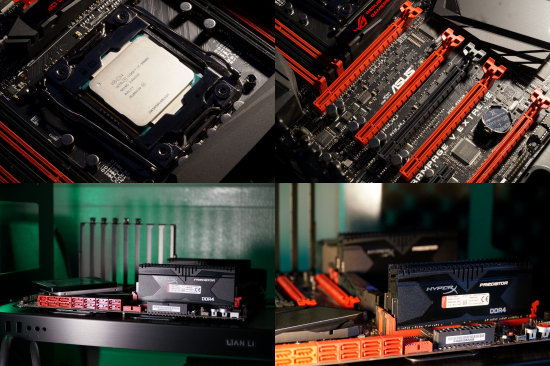
Corsair sent us over their kick-ass AX1500i PSU, which provides 1500W of power for our 3 and 4-way GPU testing that we have coming very soon.
Anthony's Video Card Test System Specifications
- Motherboard: ASUS Rampage V Extreme - Buy from Amazon / Read our review
- CPU: Intel Core i7 5960X - Buy from Amazon / Read our review
- Cooler: Corsair H110 - Buy from Amazon / Read our review
- Memory: Kingston 16GB (4x4GB) HyperX Predator DDR4 3000MHz - Buy from Amazon
- Storage #1: SanDisk Extreme II 240GB - Buy from Amazon / Read our review
- Storage #2: Intel 730 Series 480GB - Buy from Amazon / Read our review
- Case: Lian Li PC-T80 Open-Air - Buy from Amazon
- Power Supply: Corsair AX1500i - Buy from Amazon / Read our review
- OS: Microsoft Windows 10 Home 64-bit - Buy from Amazon
- Drivers: NVIDIA GeForce 368.39 and AMD Catalyst 16.6.2 hotfix
Benchmarks - Synthetic
3DMark Fire Strike - 1080p
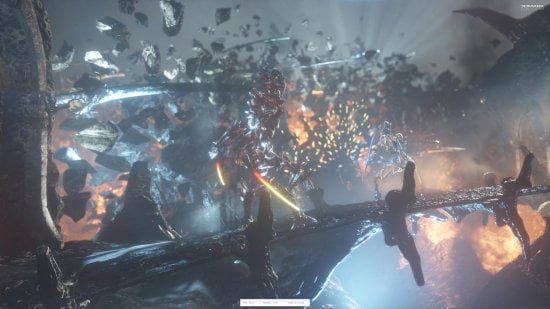
3DMark has been a staple benchmark for years now, all the way back to when The Matrix was released and Futuremark had bullet time inspired benchmarks. 3DMark is the perfect tool to see if your system - most important, your CPU and GPU - is performing as it should. You can search results for your GPU, to see if it falls in line with other systems based on similar hardware.
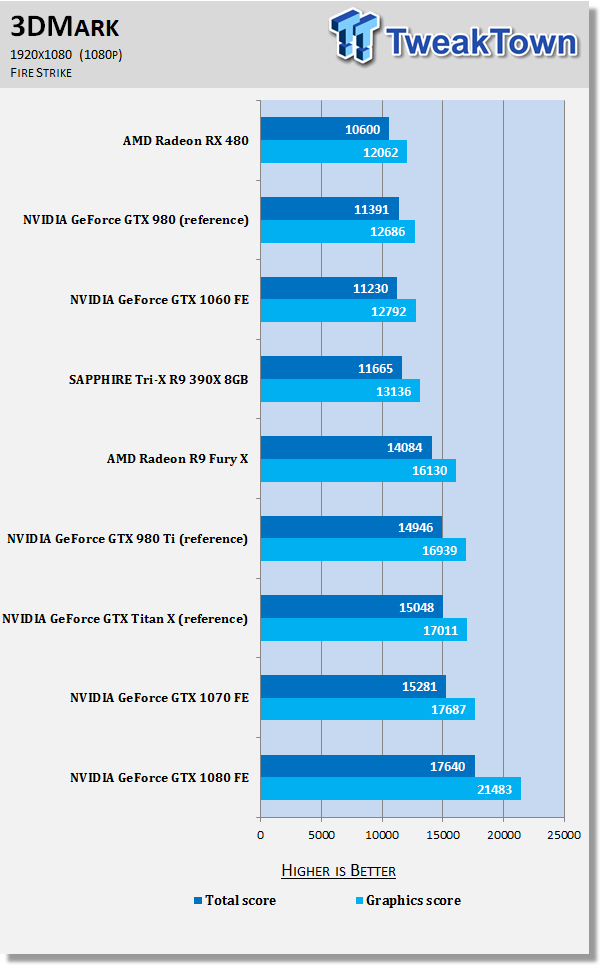
3DMark Fire Strike Extreme - 1440p
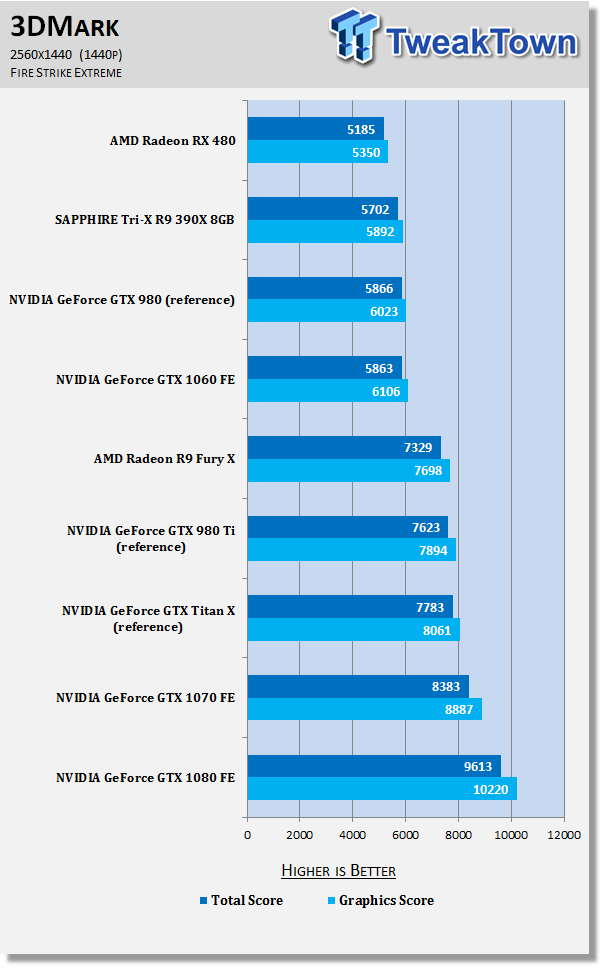
3DMark Fire Strike Ultra - 4K (3840x2160)
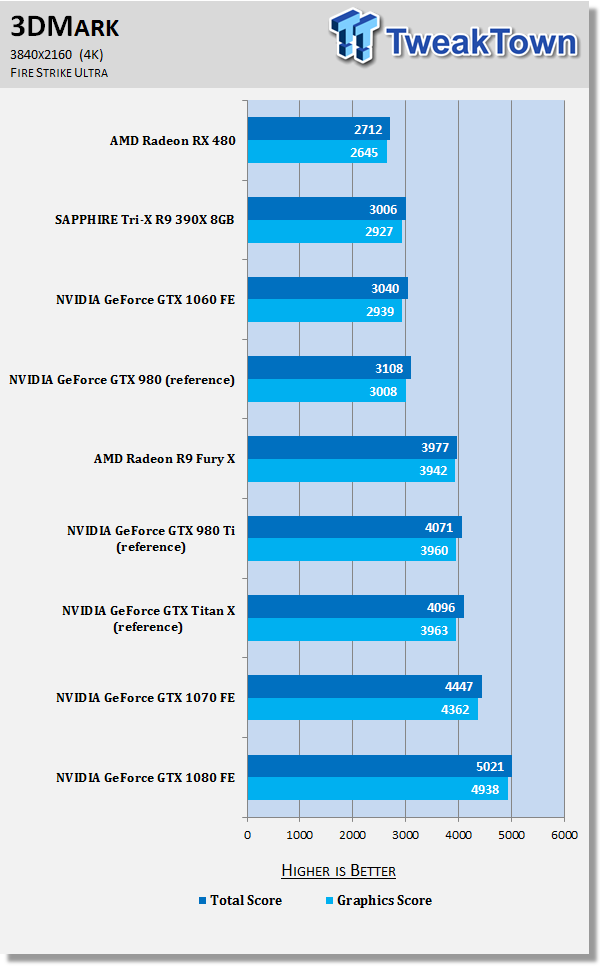
Heaven - 1080p
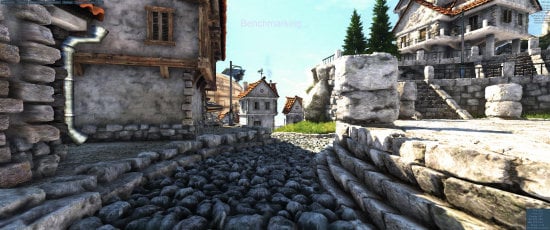
Heaven is an intensive GPU benchmark that really pushes your silicon to its limits. It's another favorite of ours as it has some great scaling for multi-GPU testing, and it's great for getting your GPU to 100% for power and noise testing.

Heaven - 1440p

Heaven - 4K (3840x2160)
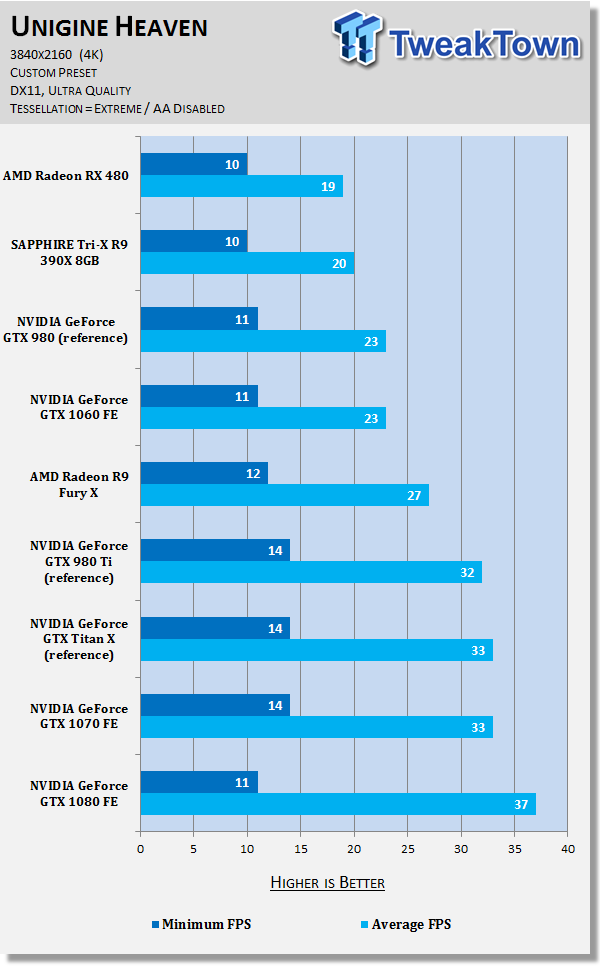
Benchmarks @ 1080p
1080p Benchmarks

Far Cry Primal is a game built on the impressive Dunia Engine 2 with wide open, beautiful environments. It might look stunning, but the performance is actually quite good - but most cards will be stressed at 1440p, and especially so at 4K and beyond.
You can buy Far Cry Primal at Amazon.
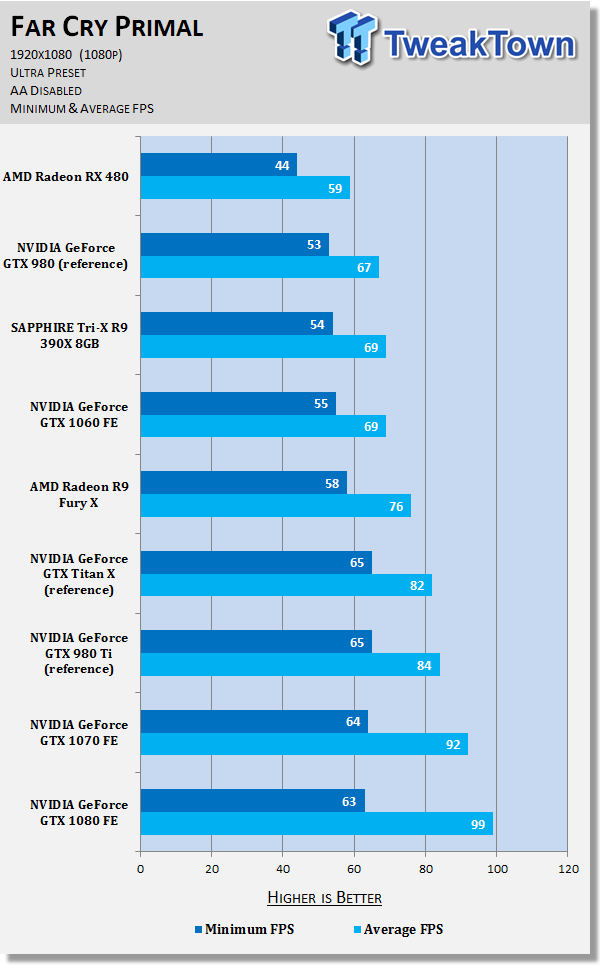

We recently changed over to Metro: Last Light Redux, with developer 4A Games making the Redux version of Metro: Last Light the 'definitive' version of the game. Redux had a fresh coat of paint on the already impressive 4A Engine, and it really pushes our GPUs to their limits.
You can buy Metro: Last Light Redux at Amazon.


Middle-earth: Shadow of Mordor is one of the most graphically intensive games we test, with Monolith using their own Lithtech engine to power the game. When cranked up to maximum detail, it will chew through your GPU and its VRAM like it's nothing.
You can buy Middle-earth: Shadow of Mordor at Amazon.


Thief has been around for quite a while now, with the latest version of the first-person stealth game powered by Epic Games' older Unreal Engine 3. While it's old, it has some great multi-GPU scaling that we use to test out our various GPU setups.
You can buy Thief at Amazon.
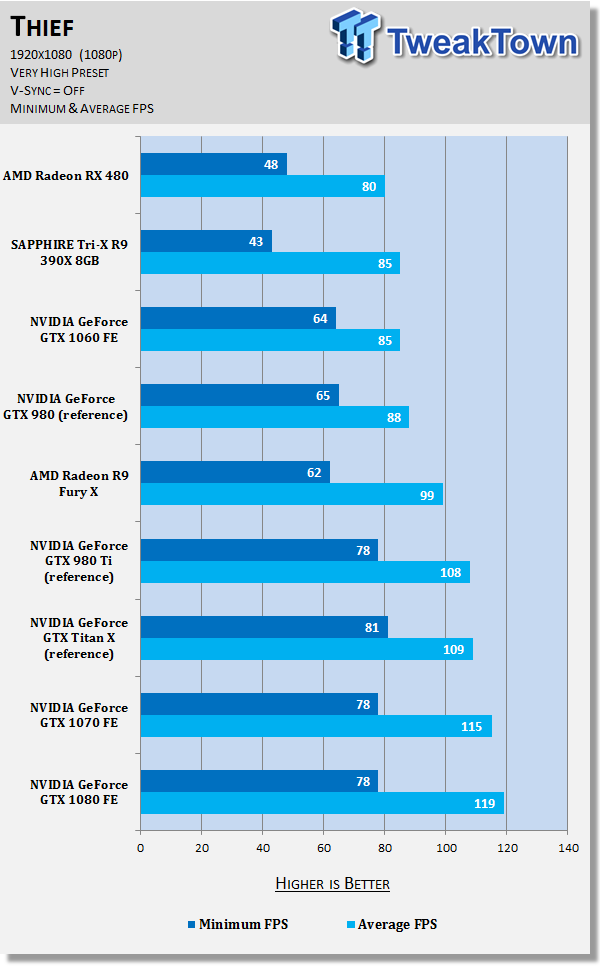
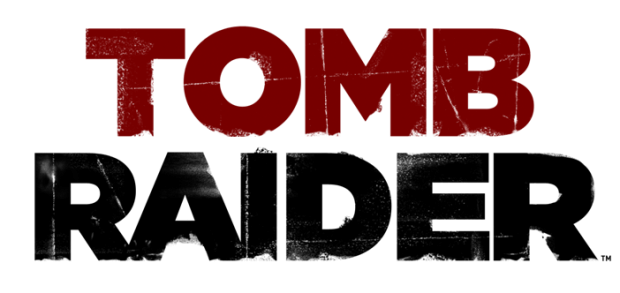
Tomb Raider is still such a gorgeous game, with developer Crystal Dynamics using their own 'Foundation' engine to build Lara Croft into the new world. One of the best parts about Tomb Raider is the absolutely stellar multi-GPU scaling, so this is an important test to see how well our NVIDIA GeForce SLI and AMD Radeon CrossFire setups scale.
You can buy Tomb Raider at Amazon.
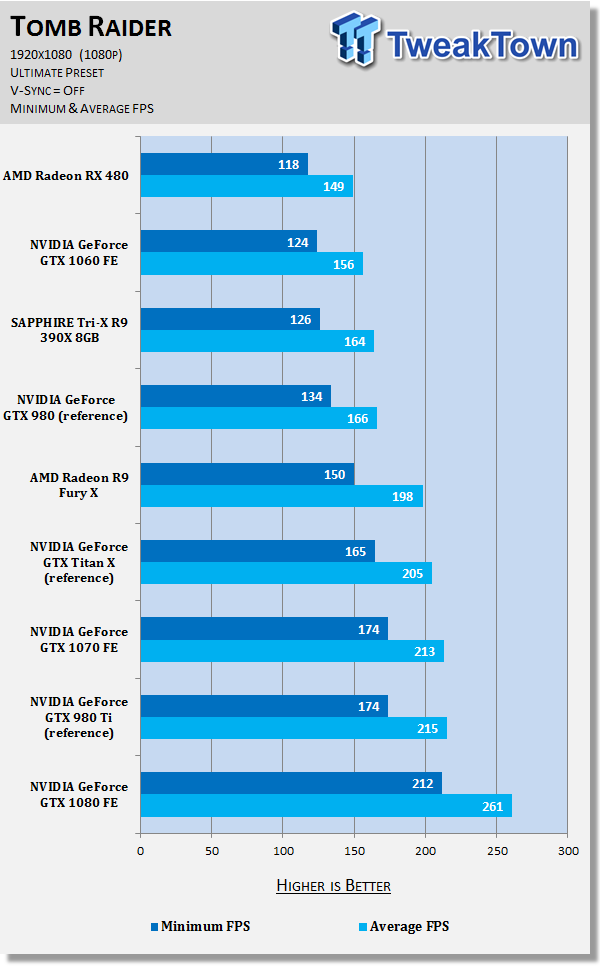
Benchmarks @ 1440p
1440p Benchmarks

Far Cry Primal is a game built on the impressive Dunia Engine 2 with wide open, beautiful environments. It might look stunning, but the performance is actually quite good - but most cards will be stressed at 1440p, and especially so at 4K and beyond.
You can buy Far Cry Primal at Amazon.


We recently changed over to Metro: Last Light Redux, with developer 4A Games making the Redux version of Metro: Last Light the 'definitive' version of the game. Redux had a fresh coat of paint on the already impressive 4A Engine, and it really pushes our GPUs to their limits.
You can buy Metro: Last Light Redux at Amazon.


Middle-earth: Shadow of Mordor is one of the most graphically intensive games we test, with Monolith using their own Lithtech engine to power the game. When cranked up to maximum detail, it will chew through your GPU and its VRAM like it's nothing.
You can buy Middle-earth: Shadow of Mordor at Amazon.


Thief has been around for quite a while now, with the latest version of the first-person stealth game powered by Epic Games' older Unreal Engine 3. While it's old, it has some great multi-GPU scaling that we use to test out our various GPU setups.
You can buy Thief at Amazon.
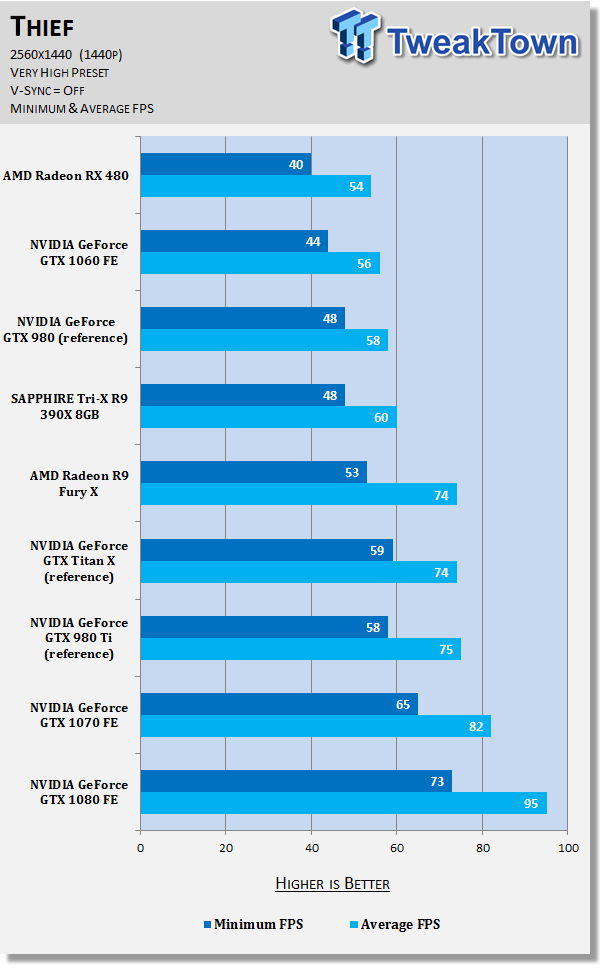

Tomb Raider is still such a gorgeous game, with developer Crystal Dynamics using their own 'Foundation' engine to build Lara Croft into the new world. One of the best parts about Tomb Raider is the absolutely stellar multi-GPU scaling, so this is an important test to see how well our NVIDIA GeForce SLI and AMD Radeon CrossFire setups scale.
You can buy Tomb Raider at Amazon.
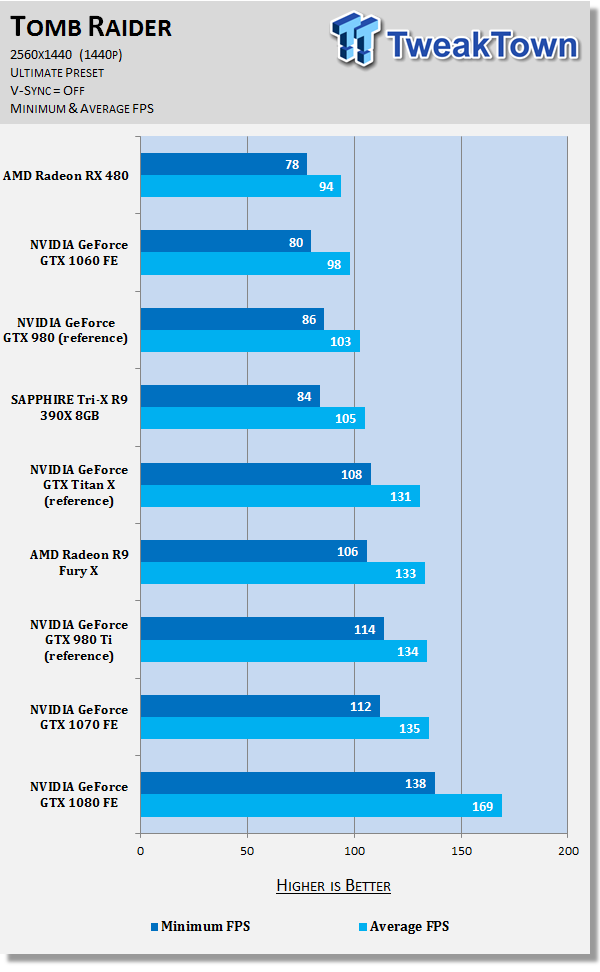
Benchmarks @ 4K
4K Benchmarks

Far Cry Primal is a game built on the impressive Dunia Engine 2 with wide open, beautiful environments. It might look stunning, but the performance is actually quite good - but most cards will be stressed at 1440p, and especially so at 4K and beyond.
You can buy Far Cry Primal at Amazon.


We recently changed over to Metro: Last Light Redux, with developer 4A Games making the Redux version of Metro: Last Light the 'definitive' version of the game. Redux had a fresh coat of paint on the already impressive 4A Engine, and it really pushes our GPUs to their limits.
You can buy Metro: Last Light Redux at Amazon.
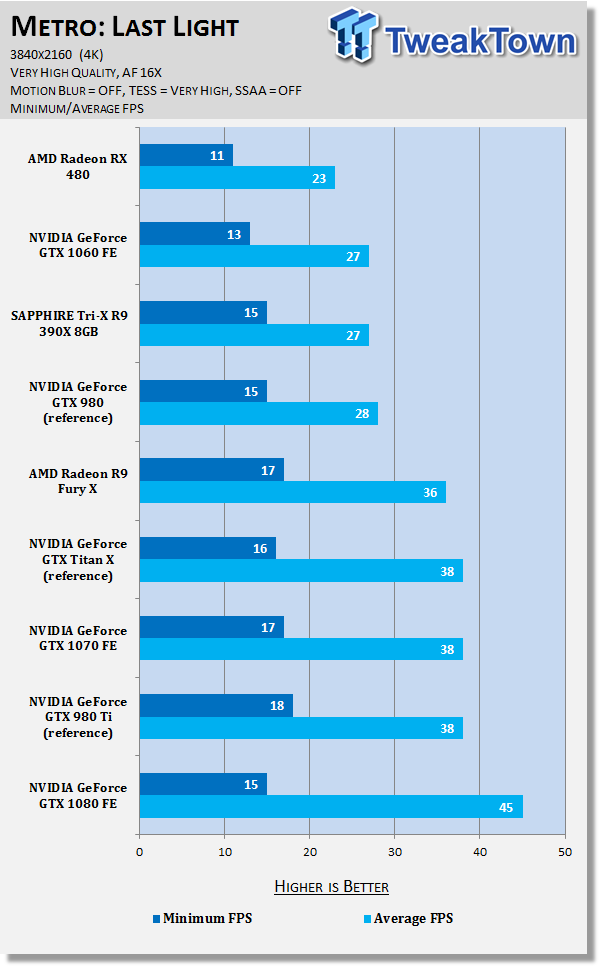

Middle-earth: Shadow of Mordor is one of the most graphically intensive games we test, with Monolith using their own Lithtech engine to power the game. When cranked up to maximum detail, it will chew through your GPU and its VRAM like it's nothing.
You can buy Middle-earth: Shadow of Mordor at Amazon.


Thief has been around for quite a while now, with the latest version of the first-person stealth game powered by Epic Games' older Unreal Engine 3. While it's old, it has some great multi-GPU scaling that we use to test out our various GPU setups.
You can buy Thief at Amazon.
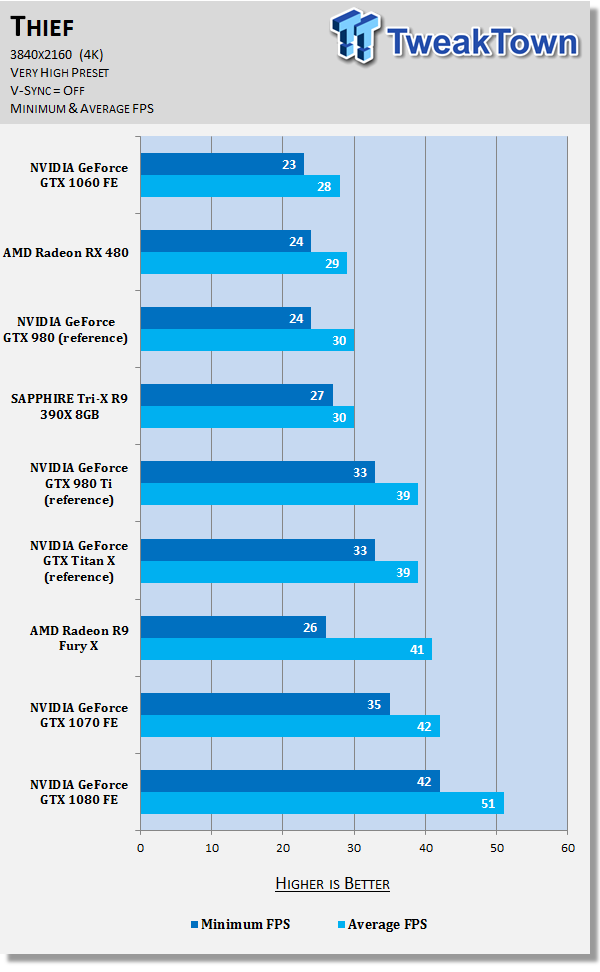

Tomb Raider is still such a gorgeous game, with developer Crystal Dynamics using their own 'Foundation' engine to build Lara Croft into the new world. One of the best parts about Tomb Raider is the absolutely stellar multi-GPU scaling, so this is an important test to see how well our NVIDIA GeForce SLI and AMD Radeon CrossFire setups scale.
You can buy Tomb Raider at Amazon.
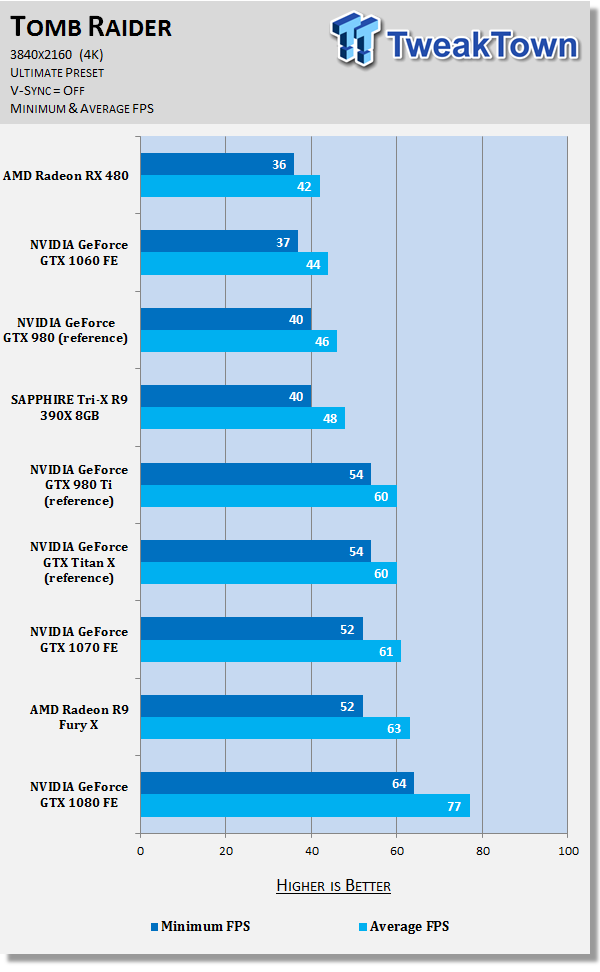
Benchmarks - DX12 & OC Adventures
This is our new section for video card reviews, with DX12 and VR becoming a huge deal over the course of the last 12 months. We have just a handful of DX12 tests right now, so expect this section of the site and our reviews to grow considerably over the coming months.
The same goes for VR, where we have both the Oculus Rift and HTC Vive in house now. We will be testing VRMark for now, which is in Preview form, as well as our thoughts on VR gaming on the HTC Vive with the new GeForce GTX 1080 video card.
DirectX 12 Performance
We have Ashes of the Singularity and Hitman with DirectX 12, with the NVIDIA GeForce GTX 1060 Founders Edition losing to AMD's Radeon RX 480 in Hitman, but just edging out the RX 480 in Ashes of the Singularity.

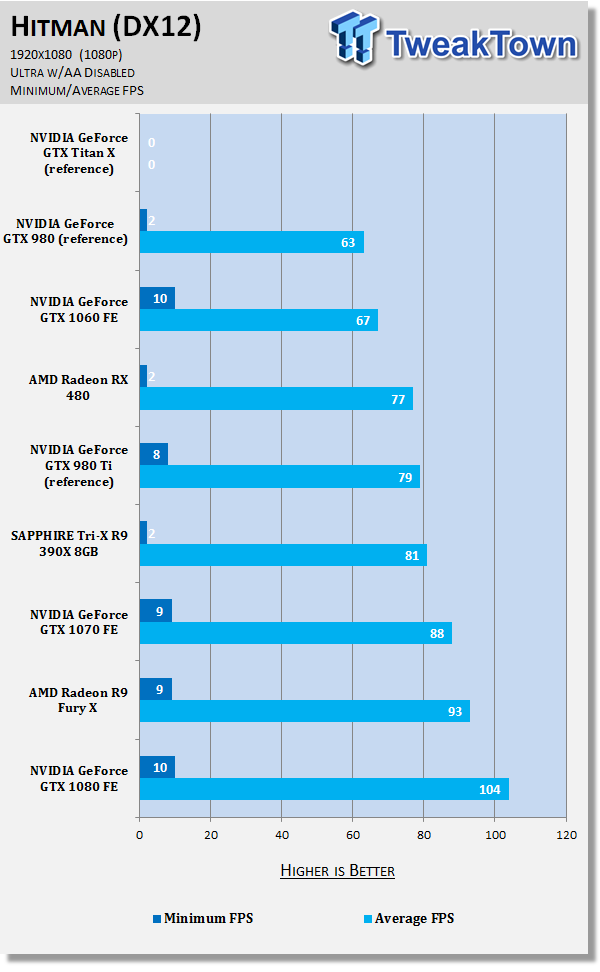



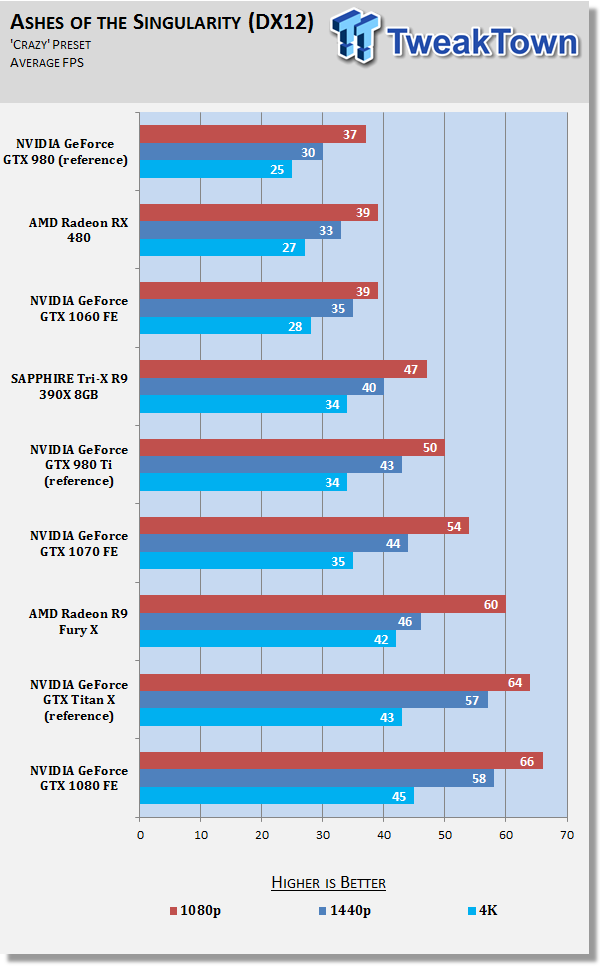
Overclocking Adventures - 2.1GHz Boost = No Problems
With NVIDIA stating that their GeForce GTX 1080 Founders Edition would hit 2.1GHz without a problem, I expected the GTX 1060 Founders Edition to not have that much overclocking headroom. But, boy was I wrong. The GP106 GPU hits 1.7GHz boost out of the box, but I was able to get my sample to 2.1GHz boost without a problem.
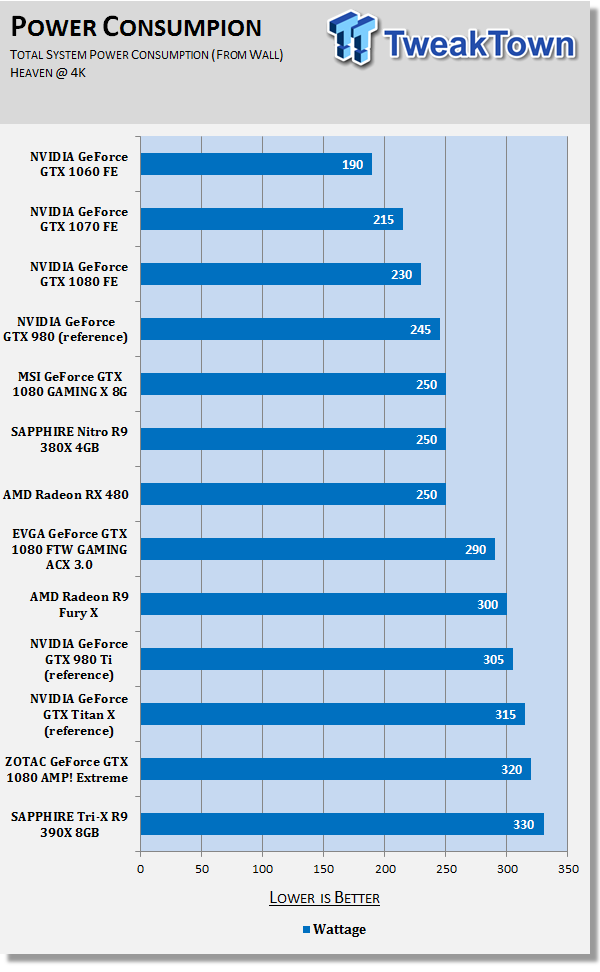
If I bumped it up by another 20MHz, it was unstable, so 2100MHz or so was rock solid. This provided more performance and didn't have the card using too much more power. The entire system was using 190W, while the overclocked card had the total system drawing 200W.
The additional performance was welcomed, as you can see in our 3DMark FireStrike benchmarks:

3DMark Fire Strike - 1080p
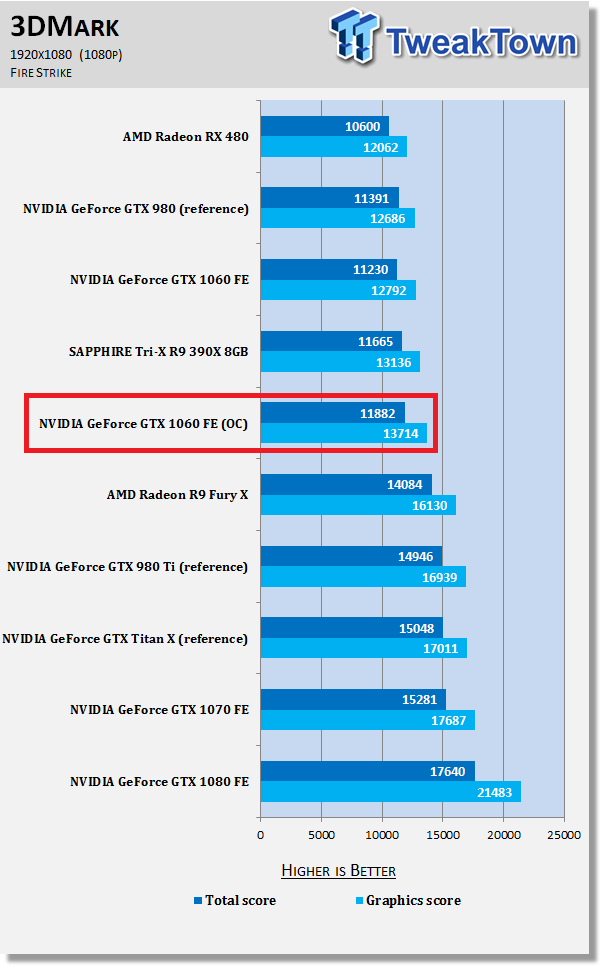
3DMark Fire Strike Extreme - 1440p
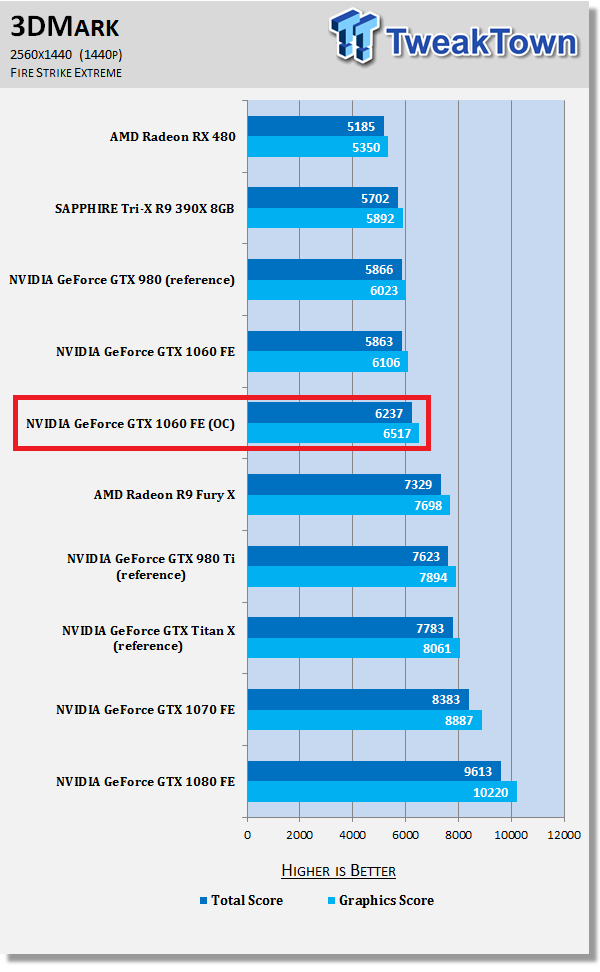
3DMark Fire Strike Ultra - 4K (3840x2160)
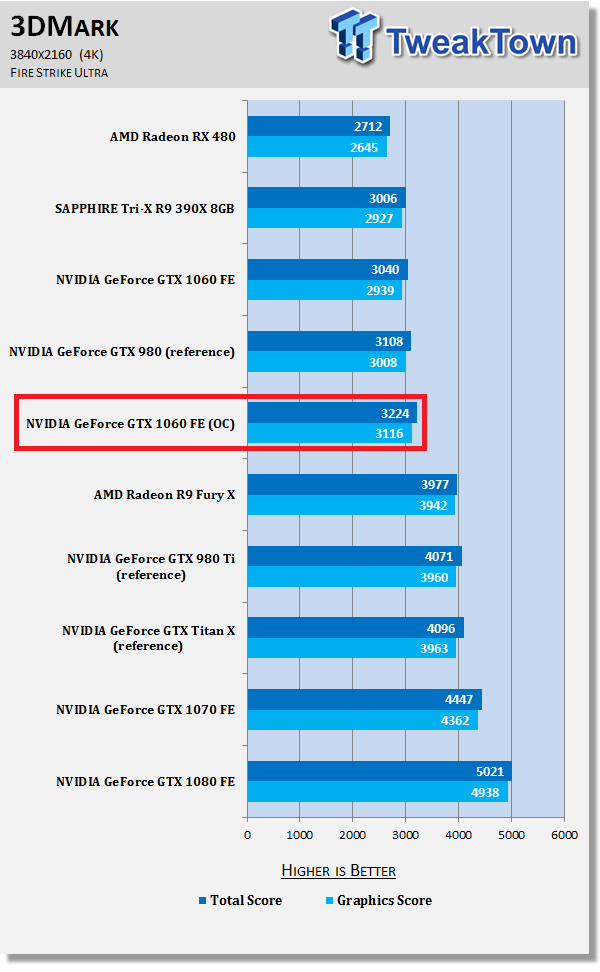
Power, Temperature, & Noise
Less Than 200W Under Load
NVIDIA has absolutely owned the power efficient GPU game since it revealed its Maxwell architecture with the announcement of the GeForce GTX 980, and has continued its efforts with Pascal and into the GeForce GTX 1060. With a 120W TDP, it's the best power/performance graphics card on the market. Our entire Core i7-5960X test bed with the GTX 1060 consumed 190W while under 100% load, which is great.
If we consider the GeForce GTX 1070 has a 150W TDP, the GTX 1060 has lowered that bar down to 120W, so you could easily power your entire PC with next-gen components and not need anything more than a quality 350W PSU. Unfortunately, there's no SLI support on the GeForce GTX 1060, so you could buy a PC with a 350W PSU and never need to worry about upgrading the power supply as you can never buy another GTX 1060 and move to an SLI system.
To compare the GeForce GTX 1060 and our full system using 200W under load, AMD's new Radeon RX 480 used 250W in our system with the original 16.6.2 drivers I used during my review. The new 16.7.1 drivers have reduced the power draw with its new Compatibility Mode, reducing the total system power draw to around 220W. Still, NVIDIA's GeForce GTX 1060 is both faster, and more power efficient than AMD's new Radeon RX 480.
Temperature & Noise
Just like the rest of the Pascal-based GeForce cards, I haven't noticed the fans getting noisy - unless I manually push the fan speed up. Sure, you can hear the fans, but you won't hear them over your gaming with your headphones on, or speakers up loud.
The NVIDIA GeForce GTX 1060 Founders Edition is the same; it's a quiet graphics card, allowing you just to get on with your gaming session.
Performance Summary & Final Thoughts
Performance Summary
NVIDIA has crafted quite the competitor to the AMD Radeon RX 480 with its new GeForce GTX 1060, but in some areas, it falls short. The big one for me is that there's no SLI support on the GTX 1060, which makes sense. NVIDIA would begin to cannibalize the sales of its GeForce GTX 1070 and GTX 1080 cards if you were able to buy two GTX 1060s and throw them into SLI.
But with AMD throwing their weight behind multi-GPU support with the Radeon RX 480s, where up to four of them can be used in CrossFire, AMD has NVIDIA bent over a barrel when it comes to multi-GPU support.
If we look at the performance between the GTX 1060 and RX 480 at 1080p, the GTX 1060 wins that battle in nearly every single game we tested - apart from the DX12-capable Hitman, where AMD comes out swinging thanks to its Asynchronous Compute superpowers. NVIDIA continues to dominate the RX 480 at 1440p, but the gap gets closer in games like Thief and Tomb Raider. AMD extends a large 14% lead over NVIDIA in Hitman running in DX12 at 1440p.
4K gaming isn't something you're going to do on the GeForce GTX 1060, but if you wanted to, you could hit 60FPS with a few adjustments to in-game visual settings. The battle between the GeForce GTX 1060 and Radeon RX 480 is much closer at 4K, as we're stretching both of the graphics cards much thinner at 3840x2160. Still, 30-40FPS in today's games isn't too bad - and as I said, with some adjustments to in-game visual settings, 60FPS isn't too far away. It's too bad that the GTX 1060 doesn't have SLI support, as the RX 480s in CrossFire kick some serious ass.
Final Thoughts
NVIDIA has pretty much grabbed the GeForce GTX 980, sprinkled some Pascal spices onto it, squeezed the PCB smaller, and popped out the GeForce GTX 1060. The $299 price on the Founders Edition is not going to win most people over, and with the current price gouging on GTX 1070s and GTX 1080s, we might see the AIB partners with their custom cards priced at over $300. This is where the battle will happen - the price.
AMD hit a clear home run pricing their Radeon RX 480 at $199/$239 for the 4GB/8GB cards, respectively, and NVIDIA hasn't hit under those prices. They come within $10 of the Radeon RX 480 8GB card with the partner cards beginning at $249, but we've learned that the prices don't mean much right now as Amazon listings for the GeForce GTX 1080 can be as high as $900 right now, even though they should be under $699.
Still, NVIDIA has crafted itself a huge competitor to the Radeon RX 480 with the GeForce GTX 1060. We have stellar 1080p and 1440p performance with a TDP that should make AMD worry. The GeForce GTX 1060 is faster in most games, more power efficient, but loses in key areas like DX12 and the lack of SLI.
The overclockability of the GeForce GTX 1060 Founders Edition is quite awesome with my sample hitting 2.1GHz on the GPU in boost. The performance gain isn't huge, but it's free performance - and that's something you should never complain about. It will be interesting to see if the custom GeForce GTX 1060s can pass 2.1GHz, but I highly doubt that as it's something that seems to happen on the custom GTX 1070s and GTX 1080s so far - even with the additional PCIe power connectors.
Once again, NVIDIA is back with a mid-range champion with the GeForce GTX 1060, but AMD has laid claim to the mid-range market with the Radeon RX 480 in the last few weeks. I think the Rebellion is working for AMD, and I think the fight won't end soon. NVIDIA is going to continue to push AMD against the wall, but also remember that AMD has the Radeon RX 470 and RX 460 up its sleeve.
What would I recommend? NVIDIA's new GeForce GTX 1060 Founders Edition or AMD's reference Radeon RX 480? That's a hard decision. If it comes down to money and you simply don't have the extra $10-$60 to spend on the GTX 1060, the RX 480 is a damn good buy. It's an even better buy when you consider you can buy a $239 card right now and then later down the track you can secure yourself a second Radeon RX 480 and go CrossFire for some great multi-GPU performance gains.
No SLI support on the GeForce GTX 1060 severely cuts its upgradability, and while I understand NVIDIA's reasoning for not having SLI support on the GTX 1060, it's going to hurt when you compare apples to apples - and in this case, the GeForce GTX 1060 against the Radeon RX 480. AMD's foresight to include CrossFire support on the Radeon RX 480 is going to go a long way to winning many mid-range gamers over.
For 1080p gamers who have been using a GeForce GTX 760 (or in that type of class) will find a great upgrade in the GeForce GTX 1060. We have Simultaneous Multi-Projection support, great VR horsepower, and an efficient GPU that won't break the PSU bank. If you've been waiting to upgrade your Team Green GPU and don't have $449+ to spend on a GeForce GTX 1070, the GeForce GTX 1060 should be on your radar.








